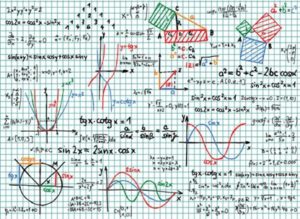How I got a 50 in Maths Methods
And how you can do the same - the 4-Step Process to Mastery
Table of Contents
Introduction
“Larry, how did you get a 50?”
This is a question I have been asked many times, but indeed it’s not as difficult as it is perceived to be. With the right study habits, techniques, and support, I truly believe that anyone has the capability of getting a 50 in Maths Methods.
When I was doing it, Maths Methods was one of, if not my favourite subject. Not only does it teach an extraordinary breadth of the type of mathematical knowledge that seamlessly transfers to the real world, it’s also assessed in a way that tests your conceptual understanding rather than regurgitating content *cough Biology cough* (DISCLAIMER: Larry does not have anything against Bio students). It’s one of those subjects that I like to call “learn it once, remember it forever” if you do it properly the first time.
Which begs the question, what is the best way to learn Maths Methods?
Well, like everything in life, there is no perfect way. What works for some people might not work for others, and everyone has their preferred learning style. What I’ll discuss in this guide comes from my personal experience, advice from my teacher (who was the Chief Examiner for Methods, weird flex but ok), as well as what I have gathered from talking to other high achieving friends. So, here is how I got a 50 in Maths Methods by taking the essential 4 steps for mastery!
Step 1: Learning the content right the first time
The first step goes without saying; just like any other subject it is always first and foremost developing a deep, but more importantly intuitive understanding of the content. (And teaching intuitively is what we specialise here at Forestree!) The concepts taught in Methods can certainly be quite abstract, but the beautiful thing is, all the pieces of knowledge can be presented visually, and what you need to look for is ways to connect separate pieces of information. I highly encourage you to be a curious learner and investigate everything thoroughly – playing around with Desmos sliders to discover all the effects of transformations, for example.
If you’re aspiring for that 45+ study score, I highly recommend you to go beyond the pace of the class and self-learn, or at least pre-study, so you can use your class time to consolidate and clarify your knowledge with your teacher. This improves your retention and class time efficiency ten-fold, and your ability to get ahead, so that you’re in control of your learning pace, will become your biggest advantage come SACs and exams.
Step 2: Apply the knowledge. Practice, practice, practice!
Ultimately, knowing about the content without application ultimately means nothing. As the saying goes, the difference between a 30 and 40 is knowledge, the difference between a 40 and 45 is understanding. What Maths Methods really assesses you isn’t just your mathematical knowledge, but is more so your ability to apply that knowledge and adapt it to all the questions.
To get ahead of the class and refine your skills, start by doing the bare minimum number of textbook questions (within reason!) to fully understand the concept. The efficacy of textbook questions is widely debated, but you’ll find that most high achievers are against the textbook grind. Because they’re just not the same style of questions you can expect in an exam. So choose a few parts of each question to expose you to a range of question styles, then ditch the textbook and dive straight into the practice tests and SACs. Forestree’s diagnostic tests are designed specifically for this purpose.
Step 3: Review your mistakes – where the real improvements occur
When doing the practice questions, the number of questions you do isn’t important. What really is important is your ability to identify your mistakes and improve. Because it doesn’t matter how many questions you do if you’re not going to learn from it. Having a solid review process will allow you to make the most of every question to be as efficient as possible with your time.
What I did was have two separate documents. The first is the mistake log categorised by Areas of Study as well as a tally of common errors at the top. The other consists of all the difficult questions I’ve come across, so I have a huge list of difficult revision material for the final pre – exam sprint. This is absolutely crucial if you want to reach the 45+ study score range, and will allow you to extract the maximum value from the minimum number of questions.

Step 4: Simulate exam conditions
By this stage, you hopefully will have a solid understanding of all the content itself, and now it’s time to do it all under exam conditions! Watch out for our upcoming Exam Accelerator module, designed to take you above and beyond to ace your exam.
Now that you’re up to Step 4, you’d think you’re almost done, right? Well no, because here are four more steps to make the most of your practice tests and exams.
1. Consistency is Key 🔑
There’s no need to do a full exam straight away. Instead, ease into it! You can start by only doing 5 questions of exam 1, or only the multiple choice in exam 2, and allocate the time accordingly (it’s 1.5 minutes per mark in Methods). After you’re more comfortable, start doing some full papers with reading time.
2. Become a harsh marker
Have you ever had that teacher who you can swear is sadistic, and would take a mark off for every trivial “mistake”? Well, now it’s your turn to be that guy! I know that it’s not fun to take lots of marks off from your paper, but something like “Oh yeah that’s totally what I meant” should never be a thought. Remember, what score you get in a practice exam means nothing – its all about what you learn from it.
3. Review your mistakes
Again, there’s no point doing the exams if you’re not going to improve from it. I suggest you make yet another document – exam logs. This allows you to learn and reflect from each mistake , and also track your improvement all in one go!
4. Full exam conditions, always
When you do an exam, make sure to do it right. It’s a hefty time commitment, andquality > quantity every day of the week. So, make the most of every opportunity. Ensure that your environment has no distractors; take with you the same pen, calculator, bound reference etc that you will use in the real exam, so you will be totally at home on the actual day. Good luck!









